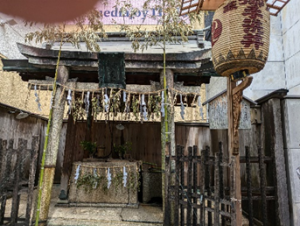Thoughts on the Gion Festival: Kyoto cultural genes The way we think about things…

Mitarai (restaurant toilet) is only open during the Gion Festival. The Mitarai (restaurant toilet) in Tearaimizucho (Karasuma Nishikiagaru) is open from Yoiyama to Kankosai. There is a legend that it is connected underground to the main hall of Yasaka Shrine.
Yoshie Doi
Since ancient times, the Japanese have had a history of singing and dancing to praise and give thanks for the blessings of heaven and earth. The metallic sound of “konkonchikitin” at the Gion Festival was apparently a tool to communicate with the heavens. From the Kojiki and Nihon Shoki, the metal sounds of Hue, Koto, Tsuzumi, and Kane were used in rituals to communicate with the heavens and pray for the elimination of epidemics.
Reverence for nature has given birth to sounds, songs, and dances, which have given rise to traditional performing arts. Lullabies, rice planting songs, rice harvesting songs, coal mining songs, and nature also contains ultra-high frequency sounds that are inaudible to the human ear.
In ancient Japan, the cherry blossom front was thought to be a sign that the gods who usually lived in the mountains were coming down from the mountain villages to the human settlements. Written as “Saza” and pronounced “Sakura,” Saza means the mountain god (god of grains), and it was thought that the cherry blossoms served as a calendar, informing people that it was time to plant rice when they were in full bloom.
There was a custom of offering sake and food to the deity under the cherry tree (Saza) where the deity resides, and receiving hand-me-downs in return. Also, since offerings alone were not enough, people began to sing songs and watch votive dances. The deity’s VIP seating was in the box seats, while common people watched on the grass on the ground, so the word “theater” was born.
This “hanami” is a custom unique to Japan and cannot be translated into English. “Hanami” instead of “picnic” cannot be translated into English. “Mottainai” and “Itadakimasu” also have no English equivalents. It is a culture unique to Japan.
Recently, there have been an increasing number of newspaper articles questioning the merits of premium seating at the Gion Festival. Most of the articles discuss the issue in a dualistic way, asking “faith or tourism?” However, from the perspective of Kyoto’s cultural heritage, I think it is possible to strike a good balance between the two, saying that it is “both a religious ceremony and a tourist attraction.
Looking back at history, the Yamahoko procession, which had been discontinued after the Onin War, was revived and established as a festival for the townspeople, and has continued to develop alongside Shinto rituals such as the portable shrine procession. I believe that the Gion Festival, which began as a way to ward off epidemics, is still held today with the same stance.
Kiyomizu-dera Temple has also been a popular temple where faith and tourism have been integrated since ancient times. I have heard this many times from the head priest of Kiyomizu-dera Temple about 30 years ago. Is it a temple of faith where you can also enjoy tourism?
I believe that by adopting a mindset that inherits Kyoto’s cultural genes and taking measures such as providing premium viewing seats for the Gion Festival so that knowledge can become wisdom, we will be able to move in a positive direction.
It is often pointed out that if the premium seats are a measure to attract the wealthy, there are no stores in Kyoto where the wealthy can buy souvenirs. This was also pointed out when I showed a magazine editor on a plane carrying people visiting Japan on private jets. In order for Kyoto to mature as an international tourist city, I would like to preserve the balance between faith and tourism.
The end of document
Translated by Masami Otani
